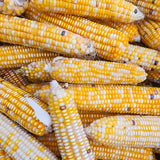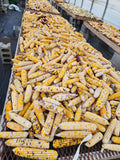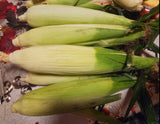African Corn
Zea mays
This African Corn is eaten grilled, boiled, fresh, or as flour. African Corn, usually called Maize, is starchy and has tougher kernels than those commonly grown in the United States. Janine Ndagijimana, who is from Burundi, received this seed from her mother in Michigan, and now grows thousands of pounds at her farm in Northern Vermont for her local food bank so they can make corn flour. Corn arrived on the African continent in the 1500s from the Americas.
Days to maturity: 100-110
Seeds per pack: 90-95
Germination rate: 98% on 04/01/2025
Planting / harvesting notes
Corn requires warm soil to germinate. Wait a week or two after the last frost and sow seeds directly in the ground. Plant in rows 2-3 feet apart. For good pollination, it is better to plant at least 3-5 shorter rows next to each other rather than one or two long rows. Sow 1 inch deep and thin to every 6-12 inches within the row. Keep soil moist until germination. Consider planting successions every few weeks for continual harvest.
Seed keeping notes
Corn is wind pollinated and should be isolated by 2-3 miles from other varieties of corn to avoid unwanted cross-pollination. Another option is to separate your corn plantings by 3-4 weeks so they do not flower/tassel at the same time. Allow the cobs and kernels to dry on the plants before harvesting for seed. If you are concerned about neighbor's corn plots hybridizing yours, consider only harvesting seed from the plants towards the middle of your plot, leaving the outer rows for eating. If necessary, lay out the cobs to do some final drying before removing the husks and seeds.















